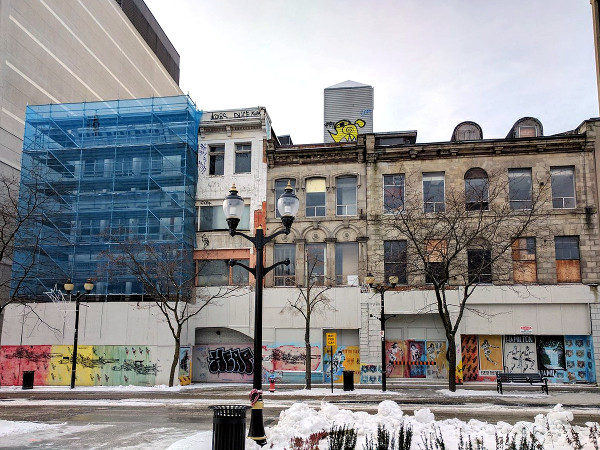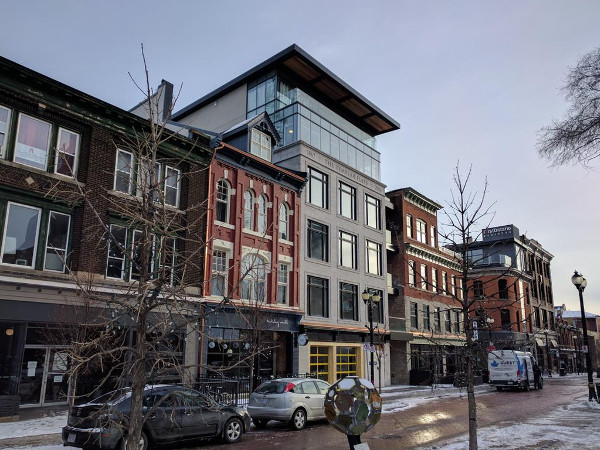With Canada's sesquicentennial coming up in 2017, we have the responsibility and duty to preserve a nationally important example of pre-Confederation architecture in the heart of Hamilton.
By Nicholas Kevlahan
Published December 16, 2016
Yesterday, I made a presentation to the Municipal Heritage Committee on behalf of Friends of the Gore, an ad hoc group formed to advocate for the continued heritage protection of 18-28 King Street East.
The agenda for the meeting includes a staff report recommending that the Committee approve property owner Wilson-Blanchard's permit applications to demolish all but the facade of 18-22 and all of 24-28.
The structural engineer commissioned by the owners wrote a report saying that 24 and 28 are structurally unsound. However, the independent peer review report by Tacoma structural engineers, who are experts in heritage building engineering, said the buildings are solid.
Bizarrely, the lawyer for Wilson-Blanchard made a rambling nostalgic intervention trying to show that he really did like the downtown and that Mr Blanchard wants to do the right thing and we should trust him (however the owners were not actually present). The intervention ended with him recalling how he actually witnessed the large stained-glass window at James Street Baptist Church, which was supposed to be safely stored, topple over and crash to bits.
This is, of course, exactly why I said in my presentation that there is no guarantee any of the conditions on safe treatment of heritage features will actually be fulfilled! We've had many cases of conditions being ignored with no repercussions on the owners, especially if ownership changes.
The Committee ended up voting to reject the demolition permit for 24-28 but to approve the partial demolition of 18-22.
Following are the speaking notes from my presentation.

18-28 King Street East (RTH file photo)
I hope you have all had a chance to read our written submission, which was distributed to you in advance of the meeting.
I have been a Hamilton resident for over 18 years, and previously lived in Vancouver, Cambridge UK, and Paris. I own, restored and had designated my 1856 stone house in the Durand Neighbourhood.
I am a Professor at McMaster University and was a member of the building committee for adaptive re-use of Hamilton Hall. This project won the Governor General's Gold Medal for architecture in 2004.
I have been active in Durand Neighbourhood Association for past 11 years, where heritage preservation has been a major priority.
I was a member of the Local Planning Committee for the National Trust for Canada Meeting in Hamilton in October 2016. I led a walking tour of the Durand neighbourhood.
I'm speaking today on behalf of the "Friends of the Gore", an ad hoc group of concerned Hamilton citizens formed in response to the proposed demolition of the historic buildings at 18-22 and 24-28 King Street East fronting onto Gore Park.
We strongly oppose granting heritage permits that will result in demolition of these buildings.
Planning staff has recommended that your committee approve these heritage permits. However, the recommendation to demolish 24-28 King Street East is not based on an evaluation of the heritage value of the buildings, their condition, or the sympathetic design of the new development.
Staff advises this permit be approved simply because staff believes this is what Council wants.
The staff report supports the heritage permit for 18-22 King Street East because it claims that the facade (the specifically designated attribute) would not be affected by the demolition of the rest of the building. This is incorrect. The proposed heritage permit will result in serious disruption effects to the designated features, i.e. changes to the setting or character of the heritage feature.
Demolition of the rest of the structure will negatively impact the heritage value of the facade by amputating its context (the rest of the building).
The designated feature will be reduced to a pastiche on a new building to be constructed behind. In fact, the staff report itself admits that "retention of a façade only is not considered a best practice."
The demolition process also poses a serious risk to the structural integrity of the 170-year-old facade itself. There is a good chance the facade will be damaged or collapse during the demolition, during the new construction, or during the indeterminate time it stands alone before any new construction begins. There is no guarantee that the suggested mitigation measures will be implemented or successful.
What's more, the report points out that the facade of 22 King Street East will, in fact, be affected by removing most of the top of the facade:
The proposal also includes rebuilding of the roof in the same gable profile, with the exception of above 22 King Street East which will be modified to accommodate an outdoor balcony space. This will however include removal of most of the parapet walls that extend from the roofline, between the buildings and on the gable ends of the buildings, with the exception of the decorative stone portions attached to decorative brackets on the front façade that are visible from King Street East.
The Municipal Heritage Committee is focused on providing advice to Council on heritage permits and the conservation of listed properties.
Your expertise is vital in assessing whether the proposed permits enhance the heritage value and conservation of these properties that Council voted to designate in December 2013. Other groups, and Council itself, can decide whether heritage is less important than the wishes of the owners.
It should be obvious that razing all these four buildings to the ground, and retaining only the facade of the pre-Confederation stone buildings, is not appropriate stewardship of these unique heritage assets. Indeed, it destroys almost all their heritage value. It also sets a terrible precedent for other heritage buildings in Hamilton.
It should be straightforward for the Municipal Heritage Committee to refuse demolition permits for buildings that Council voted to designate just three years ago. Indeed, the intent to designate notes that the architect of 18-22, William Thomas, is "a key figure in Canadian architecture," and refers to the buildings as "among very few pre-confederation stone commercial buildings remaining in Hamilton."
The new development would not only destroy the heritage values of these buildings, but the smaller replacement buildings would provide less property tax and economic development potential than the existing structures. In fact, there is no guarantee that anything at all will be built on these sites for years to come.
Because of this, I hope the committee will consider the impact of these permits not just on the buildings themselves, but on the entire Gore Park area: Hamilton's historic City Centre.
Ten years ago, in 2006, Hamilton born and raised architect Bruce Kuwabara was interviewed by CBC radio in Gore Park. He called Gore Park "one of Canada's great urban spaces" and believes that when Gore Park is once again an attractive city centre the downtown will be solidly on the road to recovery. Just last year, he reiterated the importance Gore Park on CBC Hamilton:
If he had one day as mayor of Hamilton with absolute power, Kuwabara would apply his focus to the centre of downtown, Gore Park. "It should be the focal point; the focal point should not be Jackson Square."
[...]
He said Hamilton's biggest mistake was demolishing Victorian commercial buildings to build Jackson Square. He pointed to the popularity of Locke Street and James North as evidence that "people are looking for a city, with real streets and real public space; they're not looking for a mall."
He issued one challenge to his fellow Hamiltonians: In your excitement over the momentum that's building, make sure that what you allow developers and designers to do reflects an authentic sense of the place.
"Don't yearn for what Toronto has," he said. "You'll end up killing the beauty of the place."
We should not be making the mistake of demolishing Victorian commercial buildings yet again, 40 years later!
The timing of this request is especially unfortunate since the past few years have seen renewed interest and significant investment in heritage buildings in the downtown core. We now have many examples of owners taking the time and effort to adaptively re-use their properties, and they have been successful in attracting high-end tenants to buildings that in had been largely empty for many years.
It is simply not true that adaptive reuse is too expensive, too difficult or poorly adapted to modern businesses and residential needs. It is certainly not true that we can't do it here in Hamilton!

Templar Flats on King William (RTH file photo)
The beautiful adaptive reuse project just a block away on King William and at Mills China across the street show what can be done, and that heritage buildings add real economic value. There is real demand for high quality heritage buildings downtown. Now is not the time to be reducing the supply.
When Council voted in December 2013 to designate these buildings under the Ontario Heritage Act they did so because they recognized their value to the community, now and in the future. Nothing about the heritage value of these buildings has changed, and the engineer's reports have shown them to be structurally sound.
With Canada's sesquicentennial coming up in 2017, we have the responsibility and duty to preserve a nationally important example of pre-Confederation architecture in the heart of Hamilton. The Durand Neighbourhood Association supports the retention of these buildings and the goals of the Friends of the Gore.
Please follow the precedent of The Heritage Permit Review Subcommittee and recommend denial of these heritage permit Applications. Future generations will wonder that we even considered demolition and be grateful for your decision today.
By TnT (registered) | Posted December 16, 2016 at 10:58:44
There is no video recording of this meeting unfortunately, but the delegations were inspiring. The comments from the artcitct that these "advocates" are a bunch of "fundamentalists" who don't live in the real world was less so.
By j.servus (registered) | Posted December 16, 2016 at 11:17:10
Thank you for this and all you do.
By TnT (registered) | Posted December 16, 2016 at 16:49:13 in reply to Comment 120530
It was inspiring to me as most of the delegates are very busy, very wealthy individuals who donated parts of their busy schedule come to city hall on a Thursday just because they care about the city.
By rednic (registered) | Posted December 17, 2016 at 07:28:43
Best idea is to would make the permits conditional on an inspection by a few successful downtown developers. If they believe they can save the buildings, expropriate them for assessed value and resell to the said developer. Watch how fast Blanchard changes tune, once his bluff is called.
Comment edited by rednic on 2016-12-17 08:12:48
You must be logged in to comment.
There are no upcoming events right now.
Why not post one?